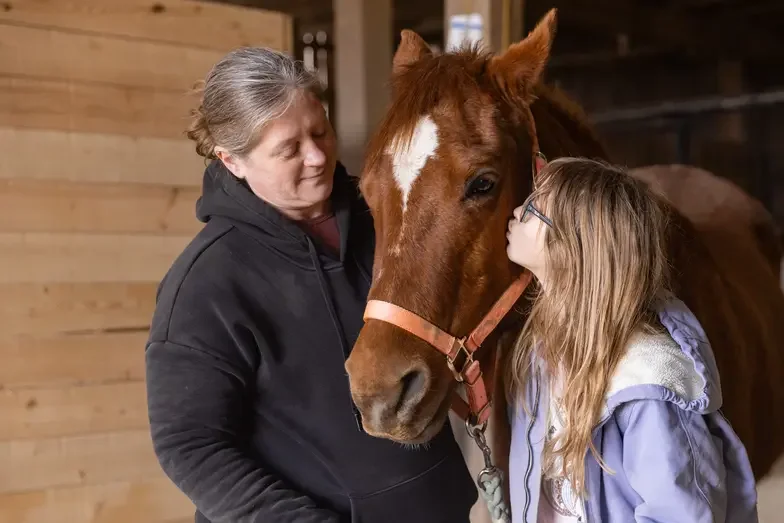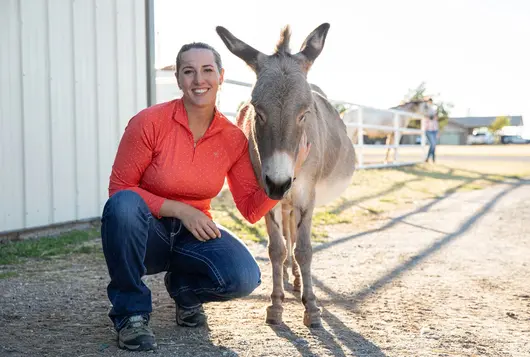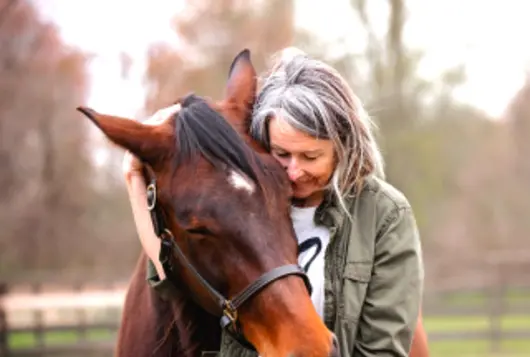The Conversational Adoption Approach: What it is, How it Helps and Tips for Getting Started

Conversational adoption is a transformative approach to connecting potential adopters with their future equine companions. By shifting from the traditional forms to dynamic, relationship-building conversations, organizations can better focus on the needs, goals and aspirations of each adopter and ultimately make better matches for their animals.
Read our interview with Libby Hanon, Marketing and Adoptions Manager at the ASPCA Equine Transition and Adoption Center, about how taking a conversational approach to adoptions can positively impact the lives of both horses and adopters.
ASPCA Pro: How do you define conversational adoptions? What are the main components of using this technique?
Hanon: The concept of conversational adoptions can be summed up by relationships. It's foundational in building relationships with people who will be one or more of the following: an immediate equine adopter, a future adopter and/or a champion of equine adoption.
Relationships are built through interpersonal communication, so we are replacing white-page forms with conversation. After gathering information about the adopter and their equine-related goals through a few welcoming, open-ended questions on our Adoption Inquiry Form, an adoption coordinator can design the next point of contact for a well-organized conversation by phone, Facetime, Zoom or other face-to-face app. During this conversation, the coordinator continues with welcoming, open-ended questions that guide the adopter through information that is important for both the organization and adopter.
Another main component of this approach is to never put the adopter on the defensive. This technique is specifically designed to break down defenses for both the adopter and the organization by making it easier to get to know one another, identify which horses would be the best fit and help fill an adopter’s resource gaps, such as a vet, farrier, boarding facility, etc.
ASPCA Pro: What are the benefits of using a conversational adoption approach?
Hanon: Just like the horses we shelter, each adopter is an individual. There are things we can learn by reading forms, but the best approach is always communication and building rapport with the people in our growing community. We can never underestimate the power in being an active listener, showing genuine interest, finding common ground, and expressing empathy and respect when speaking with anyone we hope will become an ally of equine adoption.
What I think is the most significant benefit of using a conversational adoption approach is the flipping of the script from what adopters have come to expect. Often, I can feel their nervousness when beginning a conversation. The adopter will try to tell you as many details as quickly as possible as a way for them to "be good enough" in our eyes for adoption. Through the years, it has been a joy to witness, time and again, how conversations with adopters change for the better when they aren't put on the defensive and can relax into a discussion that is friendly and curious. As I try to make good horse/adopter connections, I learn so much more about people, who inevitably become friends through this process. The trust that is built through communication is priceless!
ASPCA Pro: What steps do you take when you receive an inquiry or adoption survey from a potential home? Can you walk us through the process through the adoption?
Hanon: The first step is a strong marketing plan for each horse. Allowing a horse to "put their best hoof forward" in a transparent and informative way will allow adopters to find the right horse.
When an inquiry is received, I respond in a maximum of two business days using the same method they requested on their inquiry form (e.g., email). I also send a text message to the phone number they provide to ensure they have our number easily accessible. In this initial response, I thank them for their inquiry and express excitement about getting to know them and their needs for their next equine partner. I always invite them to a phone call at their earliest convenience and provide the best dates and times for myself in hopes that one will work with their schedule. Most of the time, these conversations happen within days of the inquiry.
After the initial conversation, I will schedule a meet and greet with the adopter and horse(s) if we’re both aligned on moving forward in the process. This meet and greet can either be in-person or virtual, depending on the location of the adopter.
The next step, assuming all goes well with the meet and greet, is having the adopter complete an adoption agreement, pay the adoption fee and schedule the horse's transport home. Communication is key in this phase, too! Keeping the adopter up to date on their horse as they wait for their transport home also builds trust within the relationship, and I have found that adopters provide open communication even after the horse arrives home. They feel inclined to send updates and for us to be their first call when a challenge arises.
“When conversational adoption approaches are used, though, I usually hear from the adopter much more frequently with photo and video updates, which speaks to the trust we've established through the adoption process.”
ASPCA Pro: How do you handle an adopter who is interested in a horse that is not their best match?
Hanon: Simply put, it's about transparency. When we share everything we know about a horse with a potential adopter, the adopter will often be able to see that a particular horse is not a good match for them. It's understandable that the adopter might feel disappointed or possibly not see that it's not a good match, so it's important for the adoption coordinator to keep the conversation positive. Discovering a match that isn't ideal is just a step closer to finding a match that is! I always make sure to let the adopter know of our other available horses, and of other ASPCA Right Horse partners' horses, that might be a good match. I also let them know they will be at the top of my list when a new horse they might like arrives at our facility. The biggest element in these situations is to stay positive and hopeful!
ASPCA Pro: What follow-up do you complete after the equine has left for their new home?
Hanon: I like to follow up with the adopter the day of or day after the horse arrives home to make sure the transport went well. I also check in at one week, one month and three months to ensure the horse is safe and sound. When conversational adoption approaches are used, though, I usually hear from the adopter much more frequently with photo and video updates, which speaks to the trust we've established through the adoption process.
ASPCA Pro: Do you have any tips for an organization just trying this approach for the first time?
Hanon: What I feel is the most powerful tool is modifying your mindset. With each inquiry received, I hold the mindset that this person could be a wonderful match for a horse, whether it’s the particular horse they are interested in or another horse. This mindset allows the adoption coordinator to see that every inquiry is a good inquiry and holds so much potential, which enables them to respond with positivity and excitement.
After modifying your mindset, whittle down your white-paper forms to brief, open-ended questions and save collecting and communicating particular details for the conversation. Always plan a few back-up options to present to the adopter before the first conversation, like other horses that may be a good match for them.
Finally, smile! Even if you're not in a smiling mood or are having a phone conversation, the act of smiling comes through positively and creates an open space for a transparent and genuine conversation.
We have lots more on this subject:



